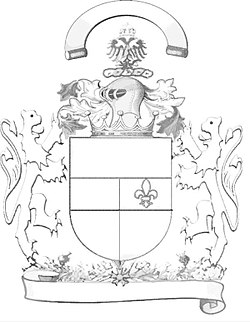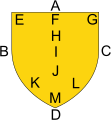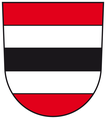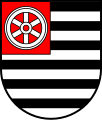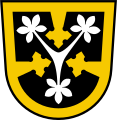Herald image
Herald's image , also called herald's figure , piece of honor and herald's piece , is a name in heraldry for a design of a coat of arms that is based on simple geometric structures .
Difference between heraldic image and common figure
The heraldic image represents a contrast to the common figure , in which living beings (such as the heraldic animal ), objects, buildings, landscape components, astronomical objects or other visually perceptible phenomena of the real world are used to design the coat of arms. In theory, common figures can also be represented in "natural colors", even if this should be avoided. Common figures usually differ from herald images in that their colored surfaces do not touch the edge of the shield. This criterion can help to differentiate in difficult borderline cases. For example with the heraldic motif of the cross : A cross with arms touching the edge of the shield is considered a herald's image. If the arms do not reach the edge of the shield, i.e. the cross is entirely within the shield, it is a common figure.
Dividing lines / dividing forms
Places and quarters
Many coats of arms can be traced back to a few elements. It is typical that the heraldic shield is divided into areas of different colors, called squares , by one or more dividing lines . The lines usually run from the edge of the shield to the edge of the shield, the colored areas of the spaces are also limited by the edge of the shield. With the simplest coats of arms, the dividing lines lie on the basic embedding lines . The colors and metals used (" tinctures ") strictly follow the heraldic color rules , that is, only the colors black, blue, green and red are used, as well as the metals gold (yellow) and silver (white). As far as geometrically possible, only color and metal touch each other. A coat of arms in red and green would be unheraldic. If three different tinctures are used, the two colors should be separated if possible, the use of two metals is rare.
Place names of a coat of arms
|
Designations of the fourth: 1 = right main section / right canton / right upper corner |

|
Names of the fourth combinations: 1, 4, 7 = right stake / right flank |
In older descriptions the shield is called in five rows with main row, honor row, middle row, navel row and foot row . There are synonyms for the middle row : belt row, band row or Schildstraße .
Division and split, change of status
There are various options for designing the dividing lines.
|
Without picture:
- divided once and split twice ( shingled or narrow shaft )
- curved and curved tip
- Sign foot and head of the shield (narrow fields respectively below. Above)
- right and left flank (one post, moved to the edge)
- Division by a cross
| Blazon | Number of lines | Area number |
|---|---|---|
| divided | a dividing line | two colored areas |
| shared twice | two dividing lines | three colored areas |
| ... | ... | ... |
| divided seven times | seven dividing lines | eight colored areas |
| ... | ... | ... |
| divided several times / multiple times | more than ten dividing lines | more than eleven division areas |
The same applies to the split. In the case of exclusively even-numbered cleavage / division and two field tingings , one speaks of piles (piles) / bars: (see below coat of arms of Chemnitz : (front) four times split from gold and blue is emblazoned as: (front) two blue piles in gold); the color to the right and left of the post / above and below the bar must be the same.
The divisions can be varied, for example, divided lower (more than half the shield at the top, then resembles a shield base , but has a different meaning).
All dividing lines can have special contours. For this see coat of arms section and overlap .
Other basic elements
Other basic elements to break down a coat of arms into the required fields are those of the rafters , the board and the nettle leaf . A wide margin calls of heraldist board . The nettle leaf is one of them. Both are parallel to the edge of the shield. The board runs at a distance from the edge of the shield and can have different line shapes. Common figures are also possible on the board .
The shingles , diamonds and wake and the chess division are an integral part of heraldry . In straight lines formed by the intersection of color change is called ge rauteten or geschachten shields. Here too, the narrower diamonds are part of it. They are then called Wecken . The heraldic pictures are complemented by the flank , the grille , the cap and the step . The cross is represented here with only one form of representation of the two possibilities as a herald image. The other form is a common figure .
The cross or the drawbar are created from the combination of crossing straight lines . The dividing lines do not have to be straight. They can also be curved, wavy or jagged, which significantly expands the design options. This type is attributed to the coat of arms . The coat of arms cuts as a shield division option is the most extensive. There are also waves , split with crenellations , jagged ( zigzag line with points ), or with a snail cut . Herald images of all kinds are possible in the upper coat of arms on common figures and their explanations are to be made as in the shield.
Examples
Particularly simple herald images can often be found, for example, on the coats of arms of the Swiss cantons (such as Friborg , Lucerne , Solothurn , Zug or Zurich ). Well-known coats of arms with herald images in Germany are the Franconian rake or the Bavarian diamond coat of arms of the Wittelsbacher .
Canton of Zurich : divided diagonally to the right by white and blue
Canton of Zug : a blue bar in the white sign
Canton of Solothurn : divided by red and white
Canton Ticino : divided by red and blue (heraldically not entirely compliant with the rules, as two colors are against each other!)
Margraviate of Baden : a diagonal red bar in the golden shield
Aistersheim / Upper Austria: divided by white and black and split twice
Franconian rake : divided into red and white by three points
The blue Landsberg piles in the Chemnitz coat of arms represent the former margraviate of Landsberg in what is now Saxony
Rear gest changes eight times of silver and red ( Ständerung in the arms of Oberdürenbach )
Dernbach (Westerwald) : divided four times by red, silver, black, silver and red
Heligoland : divided twice by green, red and silver
Massenbach : divided five times by blue and gold
upper crossing in the coat of arms of Krautheim (Jagst) (eleven times divided by black and silver)
Shield border in the coat of arms of Küllstedt
Republic of Croatia : box of red and white
Three zigzag bars in the coat of arms of the Italian family Tocco
